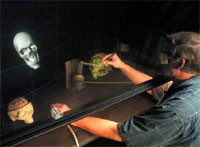Designing Cranial Implants in a Haptic Augmented Reality Environment
August 1st, 2004
Categories: Applications, Virtual Medicine, Visualization

Authors
Scharver, C., Evenhouse, R., Johnson, A., Leigh, J.About
ACM Copyright rules prohibit putting the PDF on our website. Please follow the links below to review or purchase the article.
“Designing Cranial Implants in a Haptic Augmented Reality Environment” - CAMC August 2004.
Copyright 2004 by ACM, Inc. - Copyright Restrictions on use can be viewed here.
Repairing severe human skull injuries requires customized cranial implants. Traditionally, medical sculptors have employed their anatomical modeling expertise to sculpt prosthetic implants using clay and wax. However, even with the aid of automated manufacturing techniques, the design process remains expensive in terms of labor, materials, and money. Any modification to a sculpted implant requires fabricating a new model from scratch. Techniques developed at the University of Illinois at Chicago (UIC) in 1996 have greatly improved this practice. Virtual reality research now aims to augment these tools and methods within a networked digital medium.
Closing large cranial defects offers patients therapeutic benefits, including restoring the shape of the head, protecting vital brain tissue, minimizing pain, reducing operating and recovery time, and in some cases even improving cognitive abilities. Unfortunately, many factors limit cranial implant availability. First among them, insurance companies often do not support this form of reconstruction due to the high cost of labor and manufacturing. Second, because only neurosurgeons and medical modelers have the specialized anatomical and technical knowledge to do the work, assembling the necessary expertise is difficult; travel expenses for both patients and specialists further increase the overall cost. Finally, the process of solidifying implant material exudes extreme temperatures. Exposing the brain to these temperatures damages tissue, so presurgical implant design is often critical to reducing patient risk. Traditional cranial implant fabrication and surgical placement methods depend on subjective skills and procedures.
Resources
URL
Citation
Scharver, C., Evenhouse, R., Johnson, A., Leigh, J., Designing Cranial Implants in a Haptic Augmented Reality Environment, Communications of the ACM (Special issue on Interactive immersion in 3D graphics), Volume 47, Issue 8, August 2004, pp. 32 - 38, August 1st, 2004. http://doi.acm.org/10.1145/1012037.1012059|http://www.acm.org/pubs/copyright_policy/#Notice